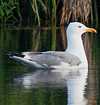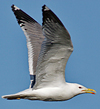 Steppe Gull - barabensis
Steppe Gull - barabensis
(last update:
Mars Muusse (Netherlands)
barabensis 1CY July
barabensis
1CY Aug
barabensis 1CY Oct
barabensis 1CY Nov
barabensis 2CY Jan
barabensis 2CY Febr
barabensis 2CY March
barabensis 2CY May
barabensis 2CY July
barabensis 2CY Nov
barabensis 3CY June
barabensis 3CY Nov
barabensis sub-ad Jan
barabensis sub-ad June
barabensis sub-ad Nov
barabensis ad Jan
barabensis ad March
barabensis ad May
barabensis ad June
barabensis ad July
barabensis ad Nov
barabensis ad Dec
At breeding location.
Identification of Steppe and Caspian Gull.
Knowledge gaps
4. Geographic variability and hybridisation in areas of overlap
There is discussion in the literature about the geographic variability of Caspian Gull (summarised in Malling Olsen & Larsson 2003) but little or no published quantitative data on the subject. So-called “eastern” Caspian Gulls reportedly have more black and less white in the wing-tip than western birds and so potentially complicate interpretation of the wing-tip trait scores presented here. The relatively invariant P10 pattern found in our Caspian sample (less black than white on P10) refers to western, ponticus-type birds. Despite statements in the literature, Caspian Gulls observed by us farther east on the breeding grounds have shown the same P10 pattern, with a whitish and deep tongue, pure white tip and less black than white, indicating stability of the basic characters of P10. During visits to southeast European Russia and southwest Siberia (May-June 2010), Caspian Gulls were found breeding in colonies along with birds phenotypically identical to “Steppe Gulls” Larus [cachinnans] barabensis; some intermediate individuals were also observed and photographed (GN unpubl. data). Presumed mixed colonies were reported from southern Siberia some years ago (Panov & Monzikov 2000). This evidence suggests that Steppe Gull is expanding its breeding range westwards and that hybridisation with Caspian is already taking place (Filchagov 1996). As a consequence of hybridisation, “eastern Caspian Gulls” with blacker wing-tips could in fact be yet another type of hybrid - between Caspian and Steppe Gulls. The influence of the latter is likely to be expressed, for example, in more black in the wing-tips of otherwise Caspian-like birds, as was observed in Siberia in 2010. Clearly, gull studies in SE Europe and western Asia are badly needed to resolve the complex relationships between these taxa.
Much of the evidence for hybridization between Caspian and Yellow-legged Gulls comes from Poland, where they now breed in a number of mixed colonies (Neubauer et al. 2006, 2009; Beran et al. 2010). However, the evidence from Poland is rather different from that from other areas of overlap (e.g. the Black Sea coast of Romania), where these species apparently do not hybridise (Klein & Buchheim 1997; Neubauer et al. 2010). There are other areas of potential overlap between these species, notably along the eastern and southeast shoreline of the Black Sea, and our understanding of the relations between Caspian and Yellow-legged Gulls would benefit from work there. The Black Sea is further interesting because the more easterly populations of Yellow-legged Gull found there appear to differ in a number of respects from western ones, including some traits that make them more similar to Caspian Gulls (e.g. more frequently a fully white tip to P10 and a longer tongue than on western birds). There remains scope for work describing quantitatively the plumage traits of eastern Yellow-legged Gulls so that the extent to which they overlap with those of other species or hybrids can be established.
5. Call and posture
Long call and long-call posture are important in the identification of Caspian Gull (details in Gibbins et al. 2010). However, there are no published data on the call or call posture of hybrids. Consequently, work is needed to determine what hybrids sound like and the posture they adopt when long-calling. Sonogram analysis, as used for example to assess the songs of Common Chiffchaff Phylloscopus collybita, Iberian Chiffchaff P. ibericus and suspected hybrids, would most likely prove insightful (Collinson & Melling 2008).
Urszulin (near Zabrodzie), Włodawa County, Lublin Voivodeship (51.4342N 23.2285E). Recorded on 2012-03-12 by: Jarek Matusiak. Colony about 32 Pairs; some birds can be hybrids among L. cachinans and L. michahellis. |
|
Góra Kalwaria (near Podłęcze), Piaseczno County, Masovian Voivodeship (52.0312N 21.2262E). Recorded on 2013-02-26 by: Jarek Matusiak. Response on White-tailed Eagle; colony of about 83 pairs; some birds can be hybrids among L. cachinnans and L. michahellis. At least 3 L. michahellis were present, and one L. f. intermedius (but silent). |
|
Rødvig havn (55.2528N 12.3737E). Recorded on 2009-10-31 by: Lars Krogh. Begging 1st winter bird. Background gulls are some L. argentatus and L. fuscus. |
 Steppe Gull barabensis adult, June 29 2014, Lake Chany, Novosibirsk, Russia. Picture: Sergey Pisarevskiy.
Steppe Gull barabensis adult, June 29 2014, Lake Chany, Novosibirsk, Russia. Picture: Sergey Pisarevskiy. Steppe Gull barabensis adult, June 28 2014, near Karasuk, Novosibirsk, Russia. Picture: Sergey Pisarevskiy.
Steppe Gull barabensis adult, June 28 2014, near Karasuk, Novosibirsk, Russia. Picture: Sergey Pisarevskiy. Steppe Gull barabensis adult, June 18 2010, near Bagan, Novosibirsk, Russia. Picture: Tatiana Bulyonkova.
Steppe Gull barabensis adult, June 18 2010, near Bagan, Novosibirsk, Russia. Picture: Tatiana Bulyonkova. Steppe Gull barabensis adult, June 28 2014, near Karasuk, Novosibirsk, Russia. Picture: Sergey Pisarevskiy.
Steppe Gull barabensis adult, June 28 2014, near Karasuk, Novosibirsk, Russia. Picture: Sergey Pisarevskiy. Steppe Gull barabensis adult, June 28 2014, near Karasuk, Novosibirsk, Russia. Picture: Sergey Pisarevskiy.
Steppe Gull barabensis adult, June 28 2014, near Karasuk, Novosibirsk, Russia. Picture: Sergey Pisarevskiy. Steppe Gull barabensis adult, June 29 2014, Lake Chany, Novosibirsk, Russia. Picture: Sergey Pisarevskiy.
Steppe Gull barabensis adult, June 29 2014, Lake Chany, Novosibirsk, Russia. Picture: Sergey Pisarevskiy. Steppe Gull barabensis adult, June 29 2014, Lake Chany, Novosibirsk, Russia. Picture: Sergey Pisarevskiy.
Steppe Gull barabensis adult, June 29 2014, Lake Chany, Novosibirsk, Russia. Picture: Sergey Pisarevskiy.below: set of pictures of barabensis type, June 2007, Sverdlovsk oblast - SE Urals. All pictures by Annika Forsten & Antero Lindholm.
 barabensis type adult, June 12 2007, Sverdlovsk oblast - SE Urals. Picture: Annika Forsten & Antero Lindholm.
barabensis type adult, June 12 2007, Sverdlovsk oblast - SE Urals. Picture: Annika Forsten & Antero Lindholm. barabensis type adult, June 12 2007, Sverdlovsk oblast - SE Urals. Picture: Annika Forsten & Antero Lindholm.
barabensis type adult, June 12 2007, Sverdlovsk oblast - SE Urals. Picture: Annika Forsten & Antero Lindholm. barabensis type adult, June 12 2007, Sverdlovsk oblast - SE Urals. Picture: Annika Forsten & Antero Lindholm.
barabensis type adult, June 12 2007, Sverdlovsk oblast - SE Urals. Picture: Annika Forsten & Antero Lindholm. barabensis type adult, June 12 2007, Sverdlovsk oblast - SE Urals. Picture: Annika Forsten & Antero Lindholm.
barabensis type adult, June 12 2007, Sverdlovsk oblast - SE Urals. Picture: Annika Forsten & Antero Lindholm. barabensis type adult, June 12 2007, Sverdlovsk oblast - SE Urals. Picture: Annika Forsten & Antero Lindholm.
barabensis type adult, June 12 2007, Sverdlovsk oblast - SE Urals. Picture: Annika Forsten & Antero Lindholm. barabensis type adult, June 06 2007, Sverdlovsk oblast - SE Urals. Picture: Annika Forsten & Antero Lindholm.
barabensis type adult, June 06 2007, Sverdlovsk oblast - SE Urals. Picture: Annika Forsten & Antero Lindholm. barabensis type adult, June 06 2007, Sverdlovsk oblast - SE Urals. Picture: Annika Forsten & Antero Lindholm.
barabensis type adult, June 06 2007, Sverdlovsk oblast - SE Urals. Picture: Annika Forsten & Antero Lindholm. barabensis type adult, June 04 2007, Sverdlovsk oblast - SE Urals. Picture: Annika Forsten & Antero Lindholm.
barabensis type adult, June 04 2007, Sverdlovsk oblast - SE Urals. Picture: Annika Forsten & Antero Lindholm. barabensis type adult, June 02 2007, Sverdlovsk oblast - SE Urals. Picture: Annika Forsten & Antero Lindholm.
barabensis type adult, June 02 2007, Sverdlovsk oblast - SE Urals. Picture: Annika Forsten & Antero Lindholm. barabensis type adult, June 02 2007, Sverdlovsk oblast - SE Urals. Picture: Annika Forsten & Antero Lindholm.
barabensis type adult, June 02 2007, Sverdlovsk oblast - SE Urals. Picture: Annika Forsten & Antero Lindholm. barabensis type adult, June 02 2007, Sverdlovsk oblast - SE Urals. Picture: Annika Forsten & Antero Lindholm.
barabensis type adult, June 02 2007, Sverdlovsk oblast - SE Urals. Picture: Annika Forsten & Antero Lindholm.below: set of pictures of eastern cachinnans, June 2011, Aktogay, East-Kazakhstan Province. All pictures by Gabor Papp.
 Larus cachinnans adult, June 07 2011, Aktogay, East-Kazakhstan Province (46,57N 79,40E). Picture: Gabor Papp.
Larus cachinnans adult, June 07 2011, Aktogay, East-Kazakhstan Province (46,57N 79,40E). Picture: Gabor Papp. Note short looking yellowish legs.
 Larus cachinnans adult, June 09 2011, Aktogay, East-Kazakhstan Province (46,57N 79,40E). Picture: Gabor Papp.
Larus cachinnans adult, June 09 2011, Aktogay, East-Kazakhstan Province (46,57N 79,40E). Picture: Gabor Papp. Homogeneous gery tone on upperparts. Many immatures.
 Larus cachinnans adult, June 07 2011, Aktogay, East-Kazakhstan Province (46,57N 79,40E). Picture: Gabor Papp.
Larus cachinnans adult, June 07 2011, Aktogay, East-Kazakhstan Province (46,57N 79,40E). Picture: Gabor Papp. Note pale iris.
 Larus cachinnans adult, June 07 2011, Aktogay, East-Kazakhstan Province (46,57N 79,40E). Picture: Gabor Papp.
Larus cachinnans adult, June 07 2011, Aktogay, East-Kazakhstan Province (46,57N 79,40E). Picture: Gabor Papp. Dark iris.
 Larus cachinnans adult, June 07 2011, Aktogay, East-Kazakhstan Province (46,57N 79,40E). Picture: Gabor Papp.
Larus cachinnans adult, June 07 2011, Aktogay, East-Kazakhstan Province (46,57N 79,40E). Picture: Gabor Papp. Dark iris.
 Larus cachinnans adult, June 07 2011, Aktogay, East-Kazakhstan Province (46,57N 79,40E). Picture: Gabor Papp.
Larus cachinnans adult, June 07 2011, Aktogay, East-Kazakhstan Province (46,57N 79,40E). Picture: Gabor Papp. Black on P3-P10 (left wing with tiny spot on P2 as well).
 Larus cachinnans adult, June 07 2011, Aktogay, East-Kazakhstan Province (46,57N 79,40E). Picture: Gabor Papp.
Larus cachinnans adult, June 07 2011, Aktogay, East-Kazakhstan Province (46,57N 79,40E). Picture: Gabor Papp. Note black on P1-P10.
 Larus cachinnans adult, June 07 2011, Aktogay, East-Kazakhstan Province (46,57N 79,40E). Picture: Gabor Papp.
Larus cachinnans adult, June 07 2011, Aktogay, East-Kazakhstan Province (46,57N 79,40E). Picture: Gabor Papp. Full subterminal band on P10.
 Larus cachinnans adult, June 07 2011, Aktogay, East-Kazakhstan Province (46,57N 79,40E). Picture: Gabor Papp.
Larus cachinnans adult, June 07 2011, Aktogay, East-Kazakhstan Province (46,57N 79,40E). Picture: Gabor Papp. Tiny mirror on P9.
 Larus cachinnans adult, June 07 2011, Aktogay, East-Kazakhstan Province (46,57N 79,40E). Picture: Gabor Papp.
Larus cachinnans adult, June 07 2011, Aktogay, East-Kazakhstan Province (46,57N 79,40E). Picture: Gabor Papp. Black on P4-P10.
 Larus cachinnans adult, June 07 2011, Aktogay, East-Kazakhstan Province (46,57N 79,40E). Picture: Gabor Papp.
Larus cachinnans adult, June 07 2011, Aktogay, East-Kazakhstan Province (46,57N 79,40E). Picture: Gabor Papp. Medium white tongue with angular end (P10 black > white).
 Larus cachinnans adult, June 07 2011, Aktogay, East-Kazakhstan Province (46,57N 79,40E). Picture: Gabor Papp.
Larus cachinnans adult, June 07 2011, Aktogay, East-Kazakhstan Province (46,57N 79,40E). Picture: Gabor Papp. P1 growing, P2 missing, P3-P10 old.
 Larus cachinnans adult, June 07 2011, Aktogay, East-Kazakhstan Province (46,57N 79,40E). Picture: Gabor Papp.
Larus cachinnans adult, June 07 2011, Aktogay, East-Kazakhstan Province (46,57N 79,40E). Picture: Gabor Papp. P1 growing, P2-P10 old / P1-P10 old.
 Larus cachinnans adult, June 07 2011, Aktogay, East-Kazakhstan Province (46,57N 79,40E). Picture: Gabor Papp.
Larus cachinnans adult, June 07 2011, Aktogay, East-Kazakhstan Province (46,57N 79,40E). Picture: Gabor Papp. Larus cachinnans adult, June 07 2011, Aktogay, East-Kazakhstan Province (46,57N 79,40E). Picture: Gabor Papp.
Larus cachinnans adult, June 07 2011, Aktogay, East-Kazakhstan Province (46,57N 79,40E). Picture: Gabor Papp.






